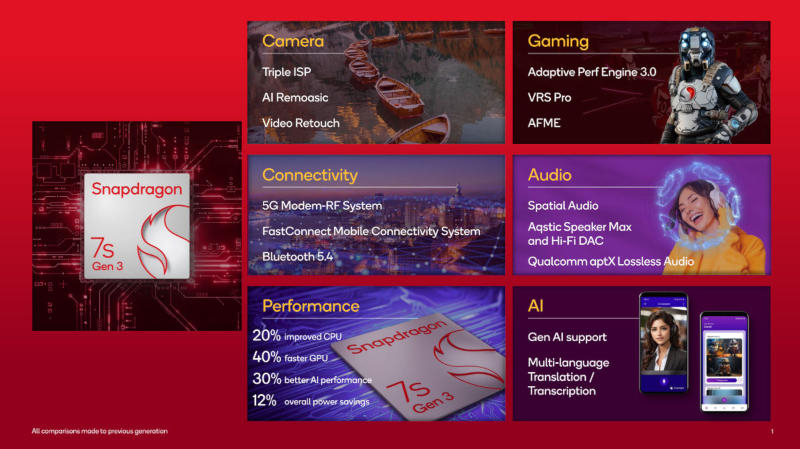Qualcomm has officially announced the Snapdragon 7s Gen 3 (SM7635) mobile platform – the most affordable of the current models of the sub-flagship seventh series. The chip manufactured using 4 nm technology has become 12% more economical. It supports running small generative AI models locally and offers better performance than its predecessor, the Snapdragon 7s Gen 2.

Image source: qualcomm.com
The Qualcomm Snapdragon 7s Gen 3 central processor is represented by a Kryo cluster, which includes one primary (Prime) core with a clock frequency of up to 2.5 GHz, three performance (Performance) up to 2.4 GHz and four effective (Efficiency) up to 1.8 GHz. This configuration provides a 20% performance increase compared to the previous generation chip.
The Qualcomm Adreno subsystem is responsible for the graphics, the manufacturer did not specify the model, but mentioned support for OpenGL ES 3.2, Vulkan 1.3, OpenCL 2.0 FP, and also noted that its performance has increased by 40%. There is hardware acceleration when working with codecs, H.265 and VP9, HDR10+ is supported. The image processor on the Snapdragon 7s Gen 3 supports up to three cameras, the maximum resolution is 200 MP; Supports video recording in 4K resolution at 30 frames per second and 1080p at 120 frames per second; and recording can be done using H.264 (AVC) and H.265 (HEVC) codecs.

The radio module supports 5G with speeds up to 2.9 Gbit/s on the incoming channel; The latest local communication standards include Wi-Fi 6E and Bluetooth 5.4 with the Bluetooth LE Audio profile. It is stated that there is a Hi-Fi class digital-to-analog converter (DAC) and a set of proprietary Qualcomm aptX codecs. USB 3.1 standard and LPDDR5 memory at 3200 MHz are supported.
Separately, Qualcomm noted a performance increase of more than 30% for the Snapdragon 7s Gen 3 in AI workloads. Large language models Baichuan-7B and Llama 2 (with 1 billion parameters) can be locally run on devices. In the coming months, devices based on Qualcomm Snapdragon 7s Gen 3 will be presented by Realme, Samsung and Sharp, and the first will be Xiaomi, which will announce its product on the new chip in September.